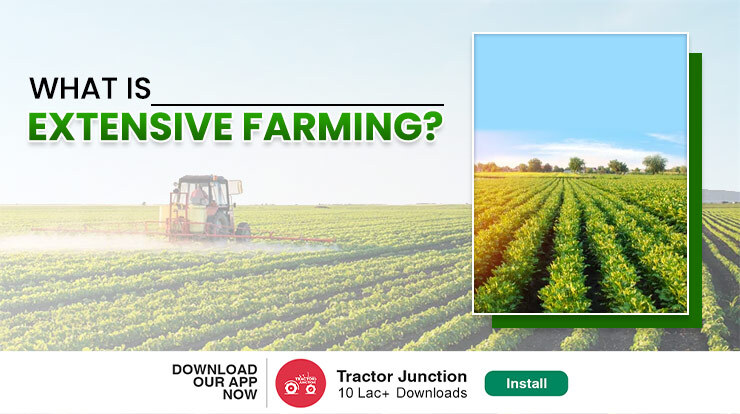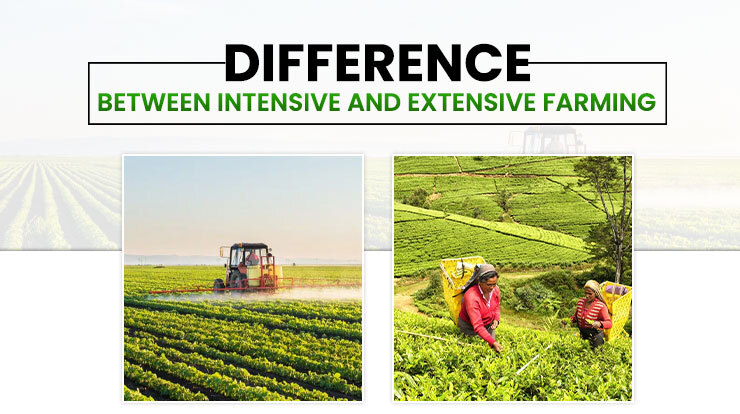
What is Extensive Farming? Let’s get familiar with the term. Extensive Farming is a kind of agriculture that uses few or no external inputs to produce crops or livestock.
Moreover, the crop yield in extensive agriculture mainly depends on the soil’s natural fertility, climate and water availability. Therefore, such farming practices use few non-renewable resources, like fertilizers and pesticides.
Hence, Extensive farmers also use sustainable practices to protect soil quality. In addition, it involves a range of activities, such as rotating crops, composting manure, organic materials from animals on the farm and rotating pastures.
Suggested Read- Top 10 Vegetables of Summer to Grow on Your Farm
Difference Between Intensive and Extensive Farming

Farming is not a one-day affair! Instead, getting the intended output requires days of hard work, and proper procedures need to be followed.
Hence, a range of farming practices has emerged to increase the productivity of the acreage. Two such farming practices are intensive farming and extensive farming.
So, Intensive Farming is a farming practice that uses higher inputs and advanced farming techniques to increase productivity.
In contrast, Extensive Farming is one in which more and more land is brought under farming to increase the output.
Features of Extensive Farming
1. Larger farm size
Farm sizes in the extensive farming system are very large, often exceeding 250 hectares.
2. High intensity of capital
The purpose of extensive farming is highly capital-intensive. Therefore, machines control the entire operation to increase the output of extensive farming.
3. The low intensity of labour
Extensive farming has a low density and is non-lucrative; therefore, very few farmers are seriously interested in it. Moreover, due to human labour scarcity, wages get higher, which prevents owners from employing a larger labour force.
4. High per capita Production
Further, Extensive farming involves continuous efforts to maximize per capita Production instead of per unit land production. Additionally, this is because each farmer controls and cultivates extensive farmland. So, per capita production increases significantly.
5. Emphasis on monocropping
Extensive farming is only limited to a definite year. Moreover, emphasis is given to producing a single crop, particularly wheat farming.
6. Commercial approach
The extensive farming system is money-minded and, therefore, highly commercialized. As a result, little is consumed by the farmers, while the bulk product is sent to the international market for export.
7. Low Production per Unit of Land
Due to the extensive nature of cropping patterns, productivity per unit of land area remains very low.
8. The dominance of single crop
Mainly wheat dominates the cultivation. Hence, 90% of the extensive farming area concentrates only on single-crop Production.
9. Huge surplus
So, Almost the entirety of the Production sent for international export.
10. Dominance of machines
Due to the shortage of human labour, the entire operation is mechanized. Therefore, machines like tractors, harvesters, winnowers, and thrashers play a significant role in extensive farming.
Also, read: Why Should You Choose the Mahindra Jivo 365 DI Tractor? for wider farm applications.
Example of Extensive Farming
Ranching, Pastoralism, Dryland farming and Agroforestry are a few types of extensive farming. However, possible examples of extensive agriculture are:
1. The farm

Clubbing livestock with agriculture is an uptick. So, it takes advantage of the animals’ natural fertilizer and the harvest’s vegetable residues.
2. Rainfed agriculture

Extensive farming often chooses winter crops like wheat, barley and rye. Therefore, it corresponds with peak humidity due to little rainfall and hence employs a natural water supply.
3. Rice plantations in Asia
India and China are the top global producers of rice. Hence, Rice plantation is carried out in wetlands that require a lot of labour and relatively little mechanized intervention.
4. Organic Crops

Extensive farming’s purpose is to dispense with all types of contaminants and machinery. Therefore, it bets on natural products, which offer food quality to the market instead of volume.
Advantages and Disadvantages of Extensive Farming
Let’s kick on to the hits and misses part and delve into the potential advantages and disadvantages of extensive farming. So, Keep reading!
What Are The Advantages of Extensive Farming?
- Total production in this farming is quite large; hence, farmers profit handsomely.
- On the other hand, production cost is low; therefore, marginal gains are high.
What Are The Disadvantages of Extensive Farming?
- Extensive farming is capital-intensive; therefore, initial capital investment is high.
- The absence of skilled agricultural labour often poses a problem in these lands of low population density.
Do you know about this talk of the town farm practice, Precision Farming? Find out more at Tractor Junction Blog
Frequently Asked Questions On Extensive Farming
Que. What do you understand about extensive farming?
Ans. Extensive farming (in contrast to intensive farming) is a farming system that utilizes small labour inputs, chemicals, and capital relative to the acreage being farmed.
Que. Where is extensive farming practised?
Ans. Extensive farming usually practised on large patches of land. This farming is predominant in US and Canada. However, in the Indian context, it is common in states like Punjab, Haryana and Uttar Pradesh.
Que. Why is extensive farming mechanized?
Ans. Extensive farming highly mechanized since such farming is carried out on very large farms. Additionally, where human and animal labour would not be sufficient for farming operations. Hence, such farming involves extensive machinery for all aspects of agriculture, from sowing to ploughing to harvesting.
Que. What is an example of extensive farming?
Ans. Pastoralism by the Maasai people of East Africa is a good example of extensive farming.
Que. What are the main crops grown in extensive farming?
Ans. Wheat, maize and barley are the main crops of extensive agriculture.
Related Post
Almond Farming in India
Top 4 Modern Farming Methods in India
What is Precision Farming

